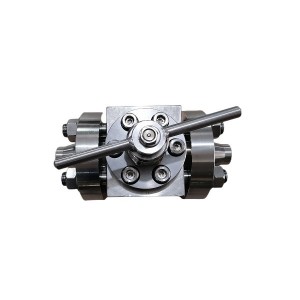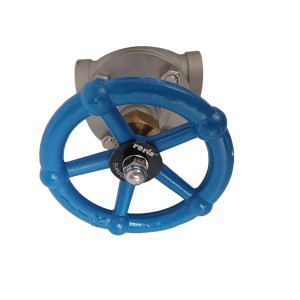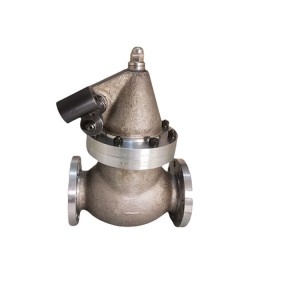In the high temperature, high pressure and corrosive working conditions of thermal power plants, the reliable operation of valves is the core to ensure the safety and efficiency of the system. The stainless steel three-piece hard-sealed ball valve Q11H-16P is widely used in key links such as steam pipelines, chemical agent transportation and water supply systems due to its high temperature resistance, corrosion resistance and high sealing performance. However, such valves are susceptible to medium erosion, temperature alternation and mechanical wear during long-term operation, resulting in sealing failure, valve seat wear or operation jamming. In response to this challenge, optimizing the disassembly and maintenance process and improving maintenance efficiency and quality have become the key to ensuring the long-term stable operation of valves.
I. Valve structure characteristics and maintenance requirements analysis
1. Three-piece design and hard sealing characteristics
The stainless steel ball valve Q11H-16P adopts a three-piece split structure of valve body, valve cover and valve seat, which is connected by precision bolts for easy disassembly and maintenance. Its hard sealing structure can withstand the erosion of high-temperature steam and corrosive media, but in long-term operation, the sealing surface is prone to scratches or wear due to friction or impurity deposition, resulting in leakage risks. Therefore, maintenance needs to focus on sealing surface repair, valve seat alignment and seal replacement.

2. Special challenges under power plant conditions
In boiler feed water, reheat steam and other systems, valves are frequently opened and closed or are in high temperature and high pressure for a long time, which can easily cause the following problems:
- Valve stem wear: High temperature steam condensate or chemical media corrodes the valve stem surface, resulting in increased operating torque.
- Packing aging: Traditional graphite packing is prone to hardening and failure at high temperatures, causing trace leakage.
- Ball offset: Vibration or uneven thermal expansion may cause the valve seat and ball to be misaligned, affecting the sealing performance.
For these problems, maintenance needs to start with disassembly and assembly process optimization, component replacement strategy and preventive measures.
II. Key points of disassembly and maintenance of ball valve Q11H-16P
1. Disassembly process and key control points
(1) Preliminary preparation
System isolation and pressure relief: Cut off the upstream and downstream media supply of ball valve Q11H-16P, completely relieve pressure through bypass or vent valve, and ensure that the pressure gauge returns to zero.
Marking and recording: Mark the bolts and gasket positions of the valve body and valve cover, and record the valve opening and sealing status before disassembly to facilitate subsequent assembly and reset.
Cooling treatment: If the valve is in a high temperature state, it needs to be cooled naturally to room temperature to avoid deformation of components or bolt jamming due to thermal expansion and contraction.
(2) Disassembly operation
Bolt removal order: Loosen the bolts connecting the valve cover and the valve body in diagonal order to avoid deformation of the valve body due to unilateral force.
Separation of valve seat and ball: Use special tools to tap the valve cover to avoid damage to the sealing surface caused by hard pulling.
Parts cleaning: Use non-woven cloth dipped in neutral detergent to remove impurities in the valve cavity, focusing on cleaning the ball surface and valve seat groove to prevent residual particles from causing jamming after assembly.
2. Inspection and evaluation
(1) Sealing surface inspection
Visual and tactile inspection: Observe whether there are scratches, pits or corrosion spots on the valve seat and ball sealing surface. Minor wear can be repaired by grinding, and serious damage requires replacement of parts.
Sealing test: Place the ball on the valve seat and preliminarily judge the sealing integrity by hand pressure or air pressure test to avoid leakage caused by sealing failure after the ball valve Q11H-16P is assembled.

(2) Valve stem and packing inspection
Valve stem surface inspection: Use a magnifying glass to observe whether there are longitudinal cracks or pitting, and replace the valve stem if necessary.
Packing status assessment: If the packing is hardened, broken, or still leaks after the gland is tightened, it needs to be replaced as a whole, and high-temperature resistant flexible graphite or polytetrafluoroethylene composite packing should be selected.
3. Assembly and commissioning optimization
(1) Component alignment and lubrication
Valve seat and ball alignment: Use a dial indicator to check the concentricity of the valve seat and the ball. If the deviation exceeds 0.05mm, the valve seat position needs to be adjusted or the ball needs to be replaced.
Valve stem lubrication: Apply molybdenum disulfide grease to the valve stem thread to reduce the opening and closing resistance and delay corrosion.
(2) Step-by-step assembly and torque control
Valve cover installation: Pre-tighten the bolts in a symmetrical order to avoid deformation of the valve body caused by excessive tightening on one side. The final torque should refer to the manufacturer’s standard, usually 120-150N·m (taking M12 bolts as an example).
Packing compression: Press the packing in layers, rotate the valve stem to check flexibility after each layer is compressed, and the final gland torque is controlled to avoid excessive tightening and causing the valve stem to jam.
The stable operation of the stainless steel three-piece hard-sealed ball valve Q11H-16P in the power plant depends on scientific and standardized disassembly and maintenance and forward-looking strategies. By optimizing the decomposition process, strengthening the inspection of key components, introducing intelligent monitoring technology and standardized operation training, the maintenance efficiency and valve reliability can be significantly improved.

When looking for high-quality, reliable ball valves, YOYIK is undoubtedly a choice worth considering. The company specializes in providing a variety of power equipment including steam turbine accessories, and has won wide acclaim for its high-quality products and services. For more information or inquiries, please contact the customer service below:
E-mail: sales@yoyik.com
Tel: +86-838-2226655
Whatsapp: +86-13618105229
Yoyik offers various types of spare parts for steam turbines, generators, boilers in power plants:
Reheater outlet plug valve SD61H-P6168V SA-182 F92
Electric stop valve J961Y-2000Lb
Servo valve of speed control system G761-3034B
Stop valve J65Y-32
Safety valve A48Y-600LB
Ball valve Q41W-16P
GEAR PUMP PFG-142-D
Globe valve WJ25F2.5P
Check valve H61Y-250P
dual solenoid valve 820023502
Thermal Power Servo Valve SM4-40(40)151-80/40-10-D305
3 port 2 way solenoid valve CCP115M
Oil station for silo looser HT-SSJ-I-1/2
Reheater inlet plugging valve SD61H-P4064 SA-105
Engine speed ratio servo valve SV4-20(15)57-80/40-10-S451
Coupling damping of oil pump HSNH440
Reheat hot forging plug valve SD61H-P5442V
PISTON ROD GLAND 223-141745-30-1
Throttle valve L61Y-P55.519V
AST valve set DSL081NRV CCP115D
solenoid valve (AST) J-110VDC-DN6-UK/83/102A
gate Z561Y-1500LB
Instrument valve J61Y-630V
Check valve H71W-16P
Stop valve J61Y-P54.5110V
Stop valve J61Y-2600SPL
Ball valve SQ11-16P
Swing Check Valve H64Y-300LB
globe shut off valve WJ20F1.6P
Bellows valves WJ10F1.6PA
Stop valve J961Y-2100SPL
Pilot relief valve DBDS10GM10/5
flow stop valve WJ40F1.6-II DN40
Post time: Mar-27-2025













